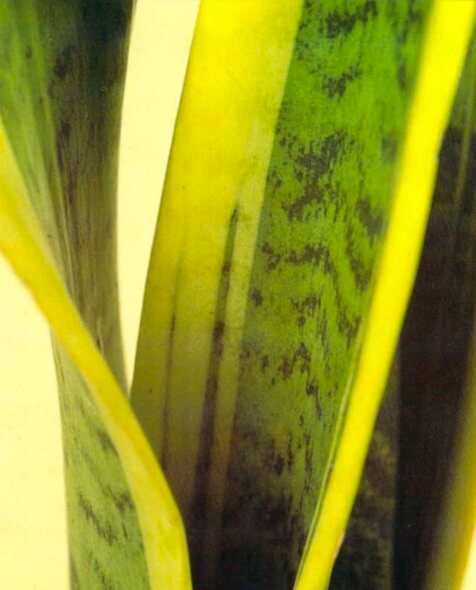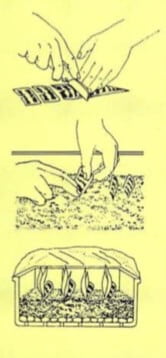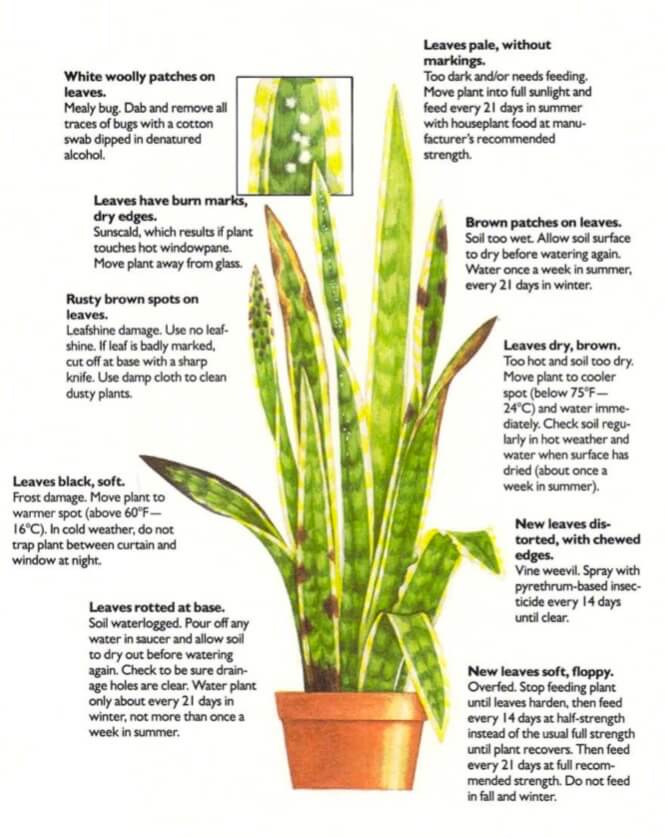[Ebook Việt Hoá] The Instant Guide to Healthy Houseplants (Hướng dẫn tức thời để chăm cây trong nhà khoẻ mạnh), Chi Sansevieria - Chi Lưỡi Hổ
[Ebook Việt Hoá] The Instant Guide to Healthy Houseplants: Sansevieria trifasciata (Mother-in-law’s tongue)
- Nguồn: [Ebook Việt Hoá] The Instant Guide to Healthy Houseplants (Hướng dẫn tức thời để chăm cây trong nhà khoẻ mạnh)
- Biên tập: Dũng Cá Xinh
- Biên dịch: Team Codai.net
English
The spear-shaped leaves of Sansevieria trifasciata provide a striking contrast to the leaves of most other houseplants and give the plant the “sharp” look that, by association, may have inspired its common name, mother-in-law’s tongue. The plant is very easy to cultivate and tolerates most conditions, though the leaves may rot if the plant is overwatered, especially in winter. Fragrant, starlike flowers grow on a stem that rises straight up from the soil beside the leaves. This stem should be removed with a sharp knife when the flowers have died. Because of its special watering needs, the plant should not be used in mixed plantings.

Light
Needs full sunlight to maintain leaf variegation but will tolerate shade.
Water
Water about once a week in summer, allowing soil surface to dry between waterings. In winter, water about every 21 days, allowing soil to dry completely between waterings. Provide good drainage.
Humidity
Plant prefers a dry atmosphere Do not mist.
Soil
Use 2 parts loam and I part sharp sand or perlite.
Feeding
During the growing season, feed plant every 21 days with houseplant food at manufacturer’s recommended strength. Do not feed in fall and winter.
Temperature
Maintain a temperature range of60-7SoF(16-24°C) year- round. Plant tolerates temperatures as low as 50°F (10°C).
Repotting
Plant thrives when somewhat pot-bound. Repot every 2-3 years, allowing roots to completely fill or even burst the pot. Plant tends to become top-heavy and can fall over; to stabilize the plant, firm soil down well around plant base.

Leaf cuttings.
- 1. With a sharp knife, cut across the base of a healthy leaf and cut the leaf into I-in (2.S-cm) sections. At the end that was closest to the stem base, slit the center of each section to make an indentation.
- 2. Insert sections, slit ends downward, midway into a tray of sand.
- 3. Water sand well and cover tray with clear plastic. Maintain temperature of 70°F (21 °C). When plants have 2 or 3 new leaves, repot each separately in small pot.
What Goes Wrong

- White woolly patches on leaves: Mealy bug. Dab and remove all traces of bugs with a cotton swab dipped in denatured alcohol.
- Leaves have bum marks, dry edges: Sunscald, which results if plant touches hot windowpane. Move plant away from glass.
- Rusty brown spots on leaves: Leafshine damage. Use no leafshine. If leaf is badly marked, cut off at base with a sharp knife. Use damp cloth to clean dusty plants.
- Leaves black, soft:Frost damage. Move plant to warmer spot (above 60°F – 16°C). In cold weather, do not trap plant between curtain and window at night.
- Leaves rotted at base: Soil waterlogged. Pour off any water in saucer and allow soil to dry out before watering again. Check to be sure drainage holes are clear. Water plant only about every 21 days in winter, not more than once a week in summer.
- Leaves pale, without markings: Too dark and/or needs feeding. Move plant into full sunlight and feed every 21 days in summer with houseplant food at manufacturer’s recommended strength.
- Brown patches on leaves: Soil too wet. Allow soil surface to dry before watering again. Water once a week in summer, every 21 days in winter.
- Leaves dry, brown: Too hot and soil too dry. Move plant to cooler spot (below 75°F – 24°C) and water immediately. Check soil regularly in hot weather and water when surface has dried (about once a week in summer).
- New leaves distorted, with chewed edges: Vine weevil. Spray with pyrethrum-based insecticide every 14 days until clear.
- New leaves soft, floppy: Overfed. Stop feeding plant until leaves harden, then feed every 14 days at half-strength instead of the usual full strength until plant recovers. Then feed every 21 days at full recommended strength. Do not feed in fall and winter.
Tiếng Việt
Những chiếc lá hình ngọn giáo của cây Sansevieria trifasciata tạo ra sự tương phản nổi bật với các loại cây trồng khác trong nhà và mang lại cho cây cái nhìn “sắc nét”, tên gọi chung của nói được lấy cảm hứng từ hình dạng lá, cây “lưỡi mẹ chồng”. Cây rất dễ trồng và thích nghi hầu hết các điều kiện nhưng lá có thể bị thối nếu bị tưới quá nhiều, đặc biệt là vào mùa đông. Những bông hoa thơm ngát mọc trên thân vươn thẳng lên khỏi mặt đất bên cạnh những chiếc lá. Cần cắt bỏ phần cuống bằng dao sắc khi hoa đã tàn. Vì nhu cầu tưới nước đặc biệt, cây không nên trồng hỗn hợp.

Ánh sáng
Cần ánh sáng mặt trời đầy đủ để duy trì những đốm nhiều màu của lá nhưng vẫn chịu được bóng râm.
Nước
Tưới nước khoảng một lần một tuần vào mùa hè, để bề mặt đất khô giữa các lần tưới. Vào mùa đông, tưới khoảng 21 ngày một lần, để đất khô hoàn toàn giữa các lần tưới. Cung cấp hệ thống thoát nước tốt.
Độ ẩm
Cây ưa không khí khô ráo. Không phun sương.
Đất
Sử dụng 2 phần đất mùn và một phần cát sắc hoặc đá trân châu.
Bón phân
Trong suốt mùa sinh trưởng, cứ 21 ngày một lần sử dụng phân bón cho cây trong nhà theo khuyến cáo của nhà sản xuất. Không bón phân vào mùa thu và mùa đông.
Nhiệt độ
Duy trì phạm vi nhiệt độ 60-75 ° F (16-24 ° C) quanh năm. Cây chịu được nhiệt độ thấp đến 50 ° F (10 ° C).
Thay chậu
Cây phát triển tốt khi trồng trong chậu. Thay chậu 2-3 năm một lần, để rễ lấp đầy hoàn toàn hoặc thậm chí làm vỡ chậu. Cây có xu hướng trở nên nặng và có thể đổ vỡ; để ổn định cây trồng, làm chắc đất tốt xuống xung quanh gốc cây.

Giâm lá
- 1. Dùng dao sắc cắt ngang phần gốc của một chiếc lá khỏe mạnh và cắt chiếc lá thành các đoạn 1 inch (2 cm). Ở phần cuối gần với gốc nhất, rạch vào giữa để tạo một vết lõm.
- 2. Ghép các phần, phần chẻ ngọn xuống dưới vào giữa khay cát.
- 3. Tưới đều cát và đậy khay bằng ni lông trong suốt. Duy trì nhiệt độ 70 ° F (21 ° C). Khi cây có 2 hoặc 3 lá mới, thay riêng từng cây vào các chậu nhỏ.
Những vấn đề có thể xảy ra

- Các mảng lông tơ màu trắng trên lá: Rệp sáp. Chấm và loại bỏ tất cả các dấu vết của bọ bằng tăm bông nhúng vào cồn biến tính.
- Lá có vết bầm, cạnh lá bị khô: Cháy nắng, điều này xảy ra do cây tiếp xúc với bề mặt nóng của cửa sổ. Hãy di chuyển cây ra xa khỏi kính cửa sổ
- Bệnh đốm nâu trên lá: Hư hại do xịt bóng lá. Không được sử dụng. Nếu lá xuất hiện những đốm nâu, hãy dùng dao sắc cắt bỏ phần gốc. Dùng khăn ẩm lau sạch bụi cho cây.
- Lá đen, mềm: Bệnh do sương giá. Di chuyển cây đến nơi ấm hơn (trên 60 ° F – 16 ° C). Khi thời tiết lạnh, không để cây giữa rèm và cửa sổ vào ban đêm.
- Lá bị thối ở gốc: Đất bị úng. Đổ hết nước vào đĩa và để đất khô trước khi tưới lại. Kiểm tra để đảm bảo các lỗ thoát nước được thông thoáng. Chỉ tưới cây khoảng 21 ngày một lần vào mùa đông, không quá một tuần một lần vào mùa hè.
- Lá nhợt nhạt, không có vết nhiều màu: Quá tối hoặc cần bón phân. Đưa cây ra nơi có ánh sáng mặt trời đầy đủ và bón phân 21 ngày một lần vào mùa hè với phân bón cho cây trồng theo khuyến cáo của nhà sản xuất.
- Các mảng màu nâu trên lá: Đất quá ẩm ướt. Để bề mặt đất khô trước khi tưới lại. Tưới nước 1 tuần / lần vào mùa hè, 21 ngày / lần vào mùa đông.
- Lá khô, nâu: Quá nóng và đất quá khô. Di chuyển cây đến chỗ mát hơn (dưới 75 ° F – 24 ° C) và tưới nước ngay lập tức. Kiểm tra đất thường xuyên khi trời nắng nóng và tưới nước khi bề mặt đã khô (khoảng một tuần một lần vào mùa hè).
- Lá mới méo mó, có mép nhăn: Sâu mọt. Phun thuốc trừ sâu pyrethrum 14 ngày một lần cho đến khi khỏi bệnh.
- Những chiếc lá mới mềm: Bón phân quá nhiều. Ngừng bón cho đến khi lá cứng lại, sau đó 14 ngày một lần bón phân với cường độ một nửa thay vì cường độ bình thường cho đến khi cây phục hồi. Sau đó, bón phân 21 ngày một lần với cường độ khuyến nghị. Không bón vào mùa thu và mùa đông.
![[Ebook Việt Hoá] The Instant Guide to Healthy Houseplants: Sansevieria trifasciata (Mother-in-law’s tongue) [Ebook Việt Hoá] The Instant Guide to Healthy Houseplants: Sansevieria trifasciata (Mother-in-law’s tongue)](https://vn1.vdrive.vn/codai.net/2020/02/ebook-huong-dan-tuc-thoi-cham-cay-trong-nha-khoe-manh-45-sansevieria-trifasciata.jpg)


